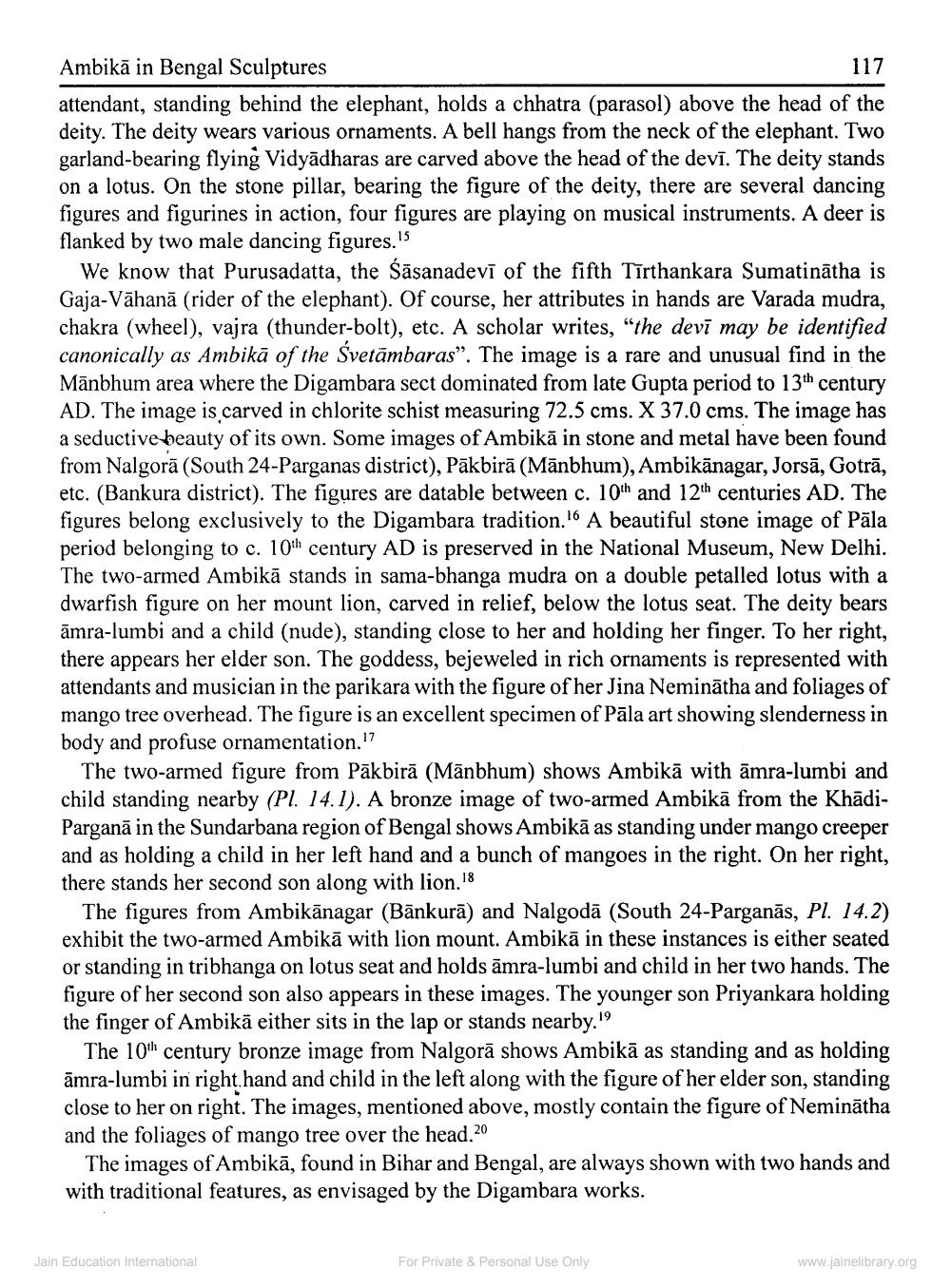________________
117
Ambikā in Bengal Sculptures attendant, standing behind the elephant, holds a chhatra (parasol) above the head of the deity. The deity wears various ornaments. A bell hangs from the neck of the elephant. Two garland-bearing flying Vidyādharas are carved above the head of the devī. The deity stands on a lotus. On the stone pillar, bearing the figure of the deity, there are several dancing figures and figurines in action, four figures are playing on musical instruments. A deer is flanked by two male dancing figures.''
We know that Purusadatta, the Sāsanadevī of the fifth Tīrthankara Sumatinātha is Gaja-Vāhanā (rider of the elephant). Of course, her attributes in hands are Varada mudra, chakra (wheel), vajra (thunder-bolt), etc. A scholar writes, "the devī may be identified canonically as Ambikā of the Svetāmbaras". The image is a rare and unusual find in the Mānbhum area where the Digambara sect dominated from late Gupta period to 13th century AD. The image is carved in chlorite schist measuring 72.5 cms. X 37.0 cms. The image has a seductive beauty of its own. Some images of Ambikā in stone and metal have been found from Nalgorā (South 24-Parganas district), Pākbirā (Mānbhum), Ambikānagar, Jorsā, Gotrā, etc. (Bankura district). The figures are datable between c. 10th and 12th centuries AD. The figures belong exclusively to the Digambara tradition. A beautiful stone image of Pāla period belonging to c. 10th century AD is preserved in the National Museum, New Delhi. The two-armed Ambikā stands in sama-bhanga mudra on a double petalled lotus with a dwarfish figure on her mount lion, carved in relief, below the lotus seat. The deity bears āmra-lumbi and a child (nude), standing close to her and holding her finger. To her right, there appears her elder son. The goddess, bejeweled in rich ornaments is represented with attendants and musician in the parikara with the figure of her Jina Neminātha and foliages of mango tree overhead. The figure is an excellent specimen of Pāla art showing slenderness in body and profuse ornamentation."
The two-armed figure from Pākbirā (Mānbhum) shows Ambikā with āmra-lumbi and child standing nearby (Pl. 14.1). A bronze image of two-armed Ambikā from the KhādiParganā in the Sundarbana region of Bengal shows Ambikā as standing under mango creeper and as holding a child in her left hand and a bunch of mangoes in the right. On her right, there stands her second son along with lion.18
The figures from Ambikānagar (Bānkurā) and Nalgodā (South 24-Parganās, Pl. 14.2) exhibit the two-armed Ambikā with lion mount. Ambikā in these instances is either seated or standing in tribhanga on lotus seat and holds āmra-lumbi and child in her two hands. The figure of her second son also appears in these images. The younger son Priyankara holding the finger of Ambikā either sits in the lap or stands nearby."
The 10th century bronze image from Nalgorā shows Ambikā as standing and as holding āmra-lumbi in right hand and child in the left along with the figure of her elder son, standing close to her on right. The images, mentioned above, mostly contain the figure of Neminātha and the foliages of mango tree over the head.20
The images of Ambikā, found in Bihar and Bengal, are always shown with two hands and with traditional features, as envisaged by the Digambara works.
Jain Education International
For Private & Personal Use Only
www.jainelibrary.org




